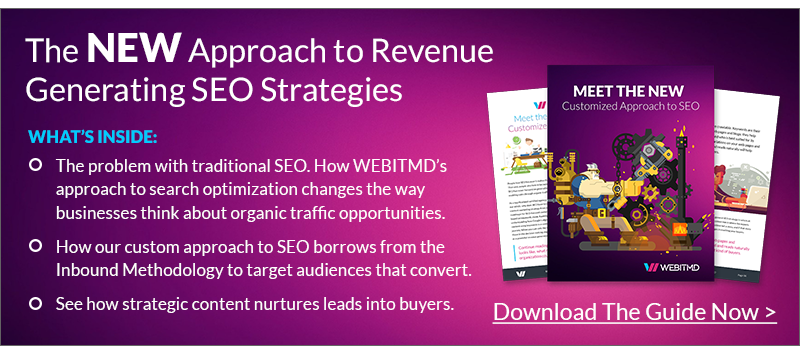Google: The Ultimate Web Master
There was a long period of time in which search engine optimization seemed to be nothing more than black-hat tricks and a little bit of luck. Instead of creating a website that appealed to the visitors, many companies were simply stuffing websites full of keywords and plastering the Web with new links, hoping to come out on top. Luckily, all that has come to a halt in recent years. The changes to Google’s ranking system has resulted in a worldwide revolution for SEO with a focus on great content and a positive user experience.
The Murky History of Search Engine Optimization
For many of us, it is difficult to imagine a world without Google and other large search engines. Billions of searches are made every single day for questions about homework, directions to a nearby restaurant, reviews on a new product, and nearly everything else imaginable. In order to match users with the correct websites, search engines such as Google have created complex algorithms that rank a website and then place the top sites on the search engine results pages (SERPs). It is an unfortunate fact that the algorithms used to rank a website were quite simplistic in those early years, and this lead to second-rate websites achieving the highest positions within the SERPs.
Many people found ways to “cheat” the system and push their website to the top of the organic searches without providing useful information. Google needed a way to bypass these black-hat tactics and push useful websites past the spam. The team at Google slowly began to alter their algorithms by placing an emphasis on different metrics to determine the value of a website. As changes were made, some of the highest-ranking websites on the internet fell to the bottom of the SERPs, while smaller websites quickly found themselves with a flood of new traffic.
A Shift in SEO
Countless developers and SEO specialists tried to find a common thread within the websites that were ranking the highest. Many began to change their tactics by altering small details such as the keyword density on a single page or increasing the amount of followers on social media accounts, but that was not enough. As time went on, it became more obvious that the goal of Google’s algorithms was very specific. These algorithms were ranking websites by the quality of their content. The happier the visitors were, the higher Google would rank the website.
Creating a Successful Website Today
Long gone are the days in which black-hat tricks will result in a successful website. Google has completely reshaped how optimization works and permanently changed the future of digital marketing. Companies that would like to improve their online presence need to maintain a world-class website with useful, pertinent, and up-to-date information. In addition to content production, a company must also have an ergonomic website that is easy to navigate and has a clear call to action.
Changing the Landscape of the Internet
Google has become unrelenting with the changes to their algorithms. In many cases, dozens of major changes have been released in a single day with websites rising and plummeting in the SERPs. The tricks that used to push a website to the highest rankings not only became ineffective, they could actually destroy the success of a website. Tactics such as spamming keywords and purchasing inbound links became Google’s #1 enemy.
A very clear example of this tumultuous period is Rand Fishkin’s entry into SEO with his now infamous website Moz.com (formerly SEOmoz.org) Fishkin began researching exactly which factors were common to sites at the top of the SERPS. SEO became something to be studied and the data, as seen in this 2007 report from SEOmoz, suggested that ranking factors were changing. Google’s changes over the next two years would effectively put an end to underhanded tricks and tactics.
Matt Cutts: The Middle Man
It should come as no surprise that web developers from around the world began to view Google as their enemy. Many firms were losing clients simply because they could not keep up with the neverending updates that were shaking up the SERPs. During this period, it was a man named Matt Cutts that helped to nurture a modicum of peace between SEO specialists and Google. Cutts was an engineer at Google that began to flood online forums with specific details about each new algorithm that was released. He currently has hundreds of videos posted all over the web – Ted Talks, SEO How to Videos, even inspirational (see his Ted Talk titled “Try Something New for 30 Days”. While Cutts is currently on leave from Google (by choice), his belief in honesty and open communication has permanently reshaped search engine customization and online marketing.
Is Google Being Honest With US?
There is no doubt about just how important Matt Cutts was to the search engine optimization industry, but Google was still not ready to reveal every card in their hand. Multiple FTC investigations against Google would reveal just how little this company was actually sharing with marketing specialists. Ad firms and SEO specialists began to see unusual behavior on their websites with hidden keywords and unspoken variables that seemed to be determining the amount of traffic that they were receiving.
It is important to note, however, that there was still a common thread between successful websites. Sites that created the best user experience continued to rank the highest, and this still holds true today. A website that is created with the visitor in mind will continue to enjoy a high volume of traffic and better conversion rates.
The Death of SEO?
Due to some of these monumental changes, many specialists are now claiming that search engine optimization is a thing of the past. While it is true that digital marketing has changed forever, it is important to understand that this is a shift in how optimization works and not the death of optimization. These new algorithms have forced companies and their marketing teams to refocus their attention and rethink the strategies that they have been using for over a decade.
Even though the world of search engine optimization seems to be bleak, there is actually a silver lining to this story. Google has successfully changed the way that websites must be built and maintained. Not only will great content and a streamlined design improve a site’s rankings, but it will also increase conversion rates. For those that take the time to create a comprehensive marketing campaign with a focus on the user’s experience, they will quickly find themselves with high-quality traffic.
Investing in the Right Tactics
Now it is clear that money invested into one’s digital marketing campaign should improve the user’s experience; this is reflected, for example, in the move towards useful and high quality long-form content. Now that the dust has settled and firms from around the world are attempting to catch up to these search engine algorithms, many are finding that they are in the perfect position to create long-term changes to their online presence. By laying a solid foundation, smaller companies can finally move past international corporations that are investing tens of millions into their online marketing.
While the algorithm changes continue to alter the marketing landscape, this shift should be seen as a positive evolution. Visitors that are looking for a specific product, service, or piece of information have a better chance at finding it in the organic search results. As for the companies that are hoping to pull in traffic and then convert that traffic into paying customers, an intuitive website with quality content still reigns supreme.





.jpg)



.jpg)





![5 Reports to Elevate Your HubSpot Sales Dashboard [+ Examples]](https://blog.webitmd.com/hs-fs/hubfs/Imported_Blog_Media/6-winning-examples-of-a-hubspot-sales-dashboard-2.png?width=767&name=6-winning-examples-of-a-hubspot-sales-dashboard-2.png)